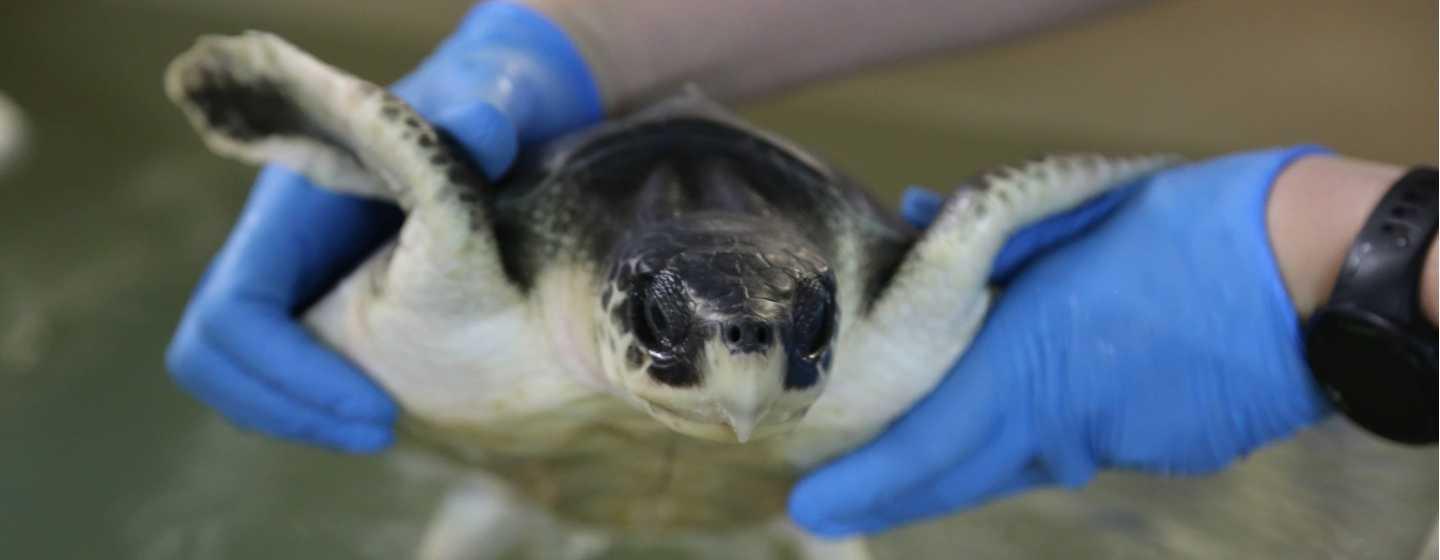Saving Cold-Stunned Sea Turtles


North Carolina Aquariums in Fort Fisher, Pine Knoll Shores and Roanoke Island, along with the Karen Beasley Sea Turtle Rescue and Rehabilitation Center in Surf City, all care for weak or injured sea turtles throughout the year. But this winter has been especially busy. At the end of December, they rescued more than 250 cold-stunned sea turtles after the temperature suddenly dropped.
“They become lethargic, unable to swim and are just floating, which means they are pushed onto the shore by the tides and the wind,” said Dr. Emily Christiansen, Chief Veterinarian for the North Carolina Aquariums. “That’s a critical time, because if they can be rescued before they succumb to the cold, they have a chance to be rehabilitated and survive.”
All species of sea turtles found along the North Carolina coast, including loggerheads, green turtles and Kemp’s ridley turtles, are affected by cold-stunning, which is like hypothermia in humans.
Sea turtles are cold-blooded reptiles. This means the temperature of their surroundings determines their body temperature. A sudden drop in temperatures cold-stuns the turtles, causing them to move slower and slower, become lethargic and eventually freeze to death.
To help a cold-stunned turtle recover, doctors and technicians slowly warm the animal to its normal body temperature. That’s between 77 and 81 degrees Fahrenheit. Turtles get into trouble when the water temperature falls to 50 degrees.
In addition, the rehab teams administer medications and treat injuries. They also help build up the turtle’s strength and stamina to make sure it is strong enough to swim in the ocean.
Once the turtle is healthy, a veterinarian gives it a final check and places a tracking microchip in its shoulder area. If the turtle is ever stranded again, its information can be scanned and retrieved. Any new information gets added to the turtle database, which is managed by federal wildlife officials but accessible to researchers nationwide.
The North Carolina Wildlife Resources Commission (NCWRC) leads the sea turtle rescue and rehabilitation network, coordinating with federal, state and private organizations.
Cold-stunned turtles found on beaches from Ocracoke and areas to the north are taken to the Sea Turtle Assistance and Rehabilitation (STAR) Center at the North Carolina Aquarium on Roanoke Island.
Cold-stunned turtles found near Cape Lookout and areas to the south are taken to North Carolina State University’s Center for Marine Science and Technology (CMAST) in Morehead City.
Following what hospitals in the human world call triage (initial treatment and assessment), the aquarium veterinary team and NCWRC staff take the turtles to rehab facilities along the coast.
“The turtles came in steadily [this winter], so a special thanks to the teams at the Aquariums, the National Parks, U.S. Fish and Wildlife Service, National Marine Fisheries Service, National Oceanic and Atmospheric Administration and N.E.S.T volunteers, who patrolled the beaches in miserably cold temperatures for days on end to find and rescue as many turtles as possible,” adds Dr. Christiansen.
N.E.S.T. stands for Network for Endangered Sea Turtles. It’s an all-volunteer nonprofit dedicated to the preservation and conservation of sea turtles and other protected marine wildlife on the Outer Banks.
The good news is that most of the turtles make a full recovery. Their release, however, is more involved than just letting them crawl down the beach to the ocean.
Crews from the Duke University Marine Lab in Beaufort, the NC Wildlife Resources Commission, the U.S. Coast Guard, NC State University’s CMAST lab and the University of North Carolina’s Institute of Marine Sciences in Morehead City as well as other volunteers transport the turtles almost 20 miles out to sea off the North Carolina coast.
What’s so special about this location? That’s where the Gulf Stream is. For most of the year, the water is a consistent 70 degrees, making it a perfect spot to release the healthy turtles.
Home sweet home.